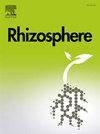在添加了胶体几丁质的培养基中进行生理驯化可提高真菌对番茄根结线虫的线虫吞噬能力
IF 3.4
3区 生物学
Q1 PLANT SCIENCES
引用次数: 0
摘要
Purpureocillium lilacinum 是一种线虫吞噬真菌,其控制植物寄生线虫 Nacobbus aberrans sensu lato 的能力已得到证实。在本研究中,利用培养基中不同的营养源和水活性水平进行了生理适应,以提高两株 P. lilacinum(SR14 和 SR38)的线虫吞噬活性。真菌接种体在添加了胶体几丁质和降低了水活性(0.95)的培养基中发育,可刺激分生孢子的产生和体外致病性。选择在这种条件下生产真菌接种体,以便对番茄植株中的阿伯兰线虫(N. aberrans s.l.)进行拮抗研究。施用 SR38 和 SR14 + SR38 后,线虫数量明显减少(94-96%)。在含有胶体几丁质和 0.95 水活度的培养基中进行生理适应,可刺激丝核菌 SR38 的致病机制(孢子和感染性),提高其线虫吞噬能力。本文章由计算机程序翻译,如有差异,请以英文原文为准。
Physiological acclimatization in a medium amended with colloidal chitin improves the nematophagous capacity of a fungus on the tomato root-knot nematode
Purpureocillium lilacinum is a nematophagous fungus whose ability to control the plant parasitic nematode Nacobbus aberrans sensu lato has been demonstrated. In this study, physiological acclimatization was performed using different nutrient sources and water activity levels of the culture medium to improve the nematophagous activity of two strains of P. lilacinum (SR14 and SR38). The development of the fungal inoculum in a medium amended with colloidal chitin and reduced levels of water activity (0.95) stimulates the production of conidia and pathogenicity in vitro. This condition was selected to produce the fungal inoculum for conducting antagonism studies against N. aberrans s.l. in tomato plants. The nematode population was significantly reduced (94–96%) with the application of SR38 and SR14 + SR38. The physiological acclimatization in medium with colloidal chitin and 0.95 water activity stimulates the pathogenicity mechanisms (sporulation and infectivity) of P. lilacinum SR38, improving its nematophagous capacity.
求助全文
通过发布文献求助,成功后即可免费获取论文全文。
去求助
来源期刊

Rhizosphere
Agricultural and Biological Sciences-Agronomy and Crop Science
CiteScore
5.70
自引率
8.10%
发文量
155
审稿时长
29 days
期刊介绍:
Rhizosphere aims to advance the frontier of our understanding of plant-soil interactions. Rhizosphere is a multidisciplinary journal that publishes research on the interactions between plant roots, soil organisms, nutrients, and water. Except carbon fixation by photosynthesis, plants obtain all other elements primarily from soil through roots.
We are beginning to understand how communications at the rhizosphere, with soil organisms and other plant species, affect root exudates and nutrient uptake. This rapidly evolving subject utilizes molecular biology and genomic tools, food web or community structure manipulations, high performance liquid chromatography, isotopic analysis, diverse spectroscopic analytics, tomography and other microscopy, complex statistical and modeling tools.
 求助内容:
求助内容: 应助结果提醒方式:
应助结果提醒方式:


